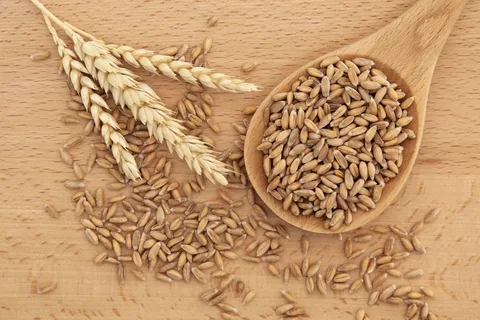Understanding Spelt
What is Spelt?
Spelt (Triticum spelta) is an ancient grain closely related to modern wheat, belonging to the same botanical family as wheat but with distinct characteristics. Spelt has been cultivated for thousands of years and was a staple food in many ancient civilizations, including those in Europe and the Middle East.
Nutritional Profile of Spelt
Spelt is a nutrient-dense grain that offers several essential nutrients, including:
Protein
Spelt is a good source of plant-based protein, containing all nine essential amino acids needed for muscle repair and growth.
Dietary Fiber
Spelt is rich in dietary fiber, including both soluble and insoluble fiber, which supports digestive health and helps regulate bowel movements.
Vitamins and Minerals
Spelt provides various vitamins and minerals, including B vitamins (such as niacin, thiamine, and riboflavin), iron, magnesium, phosphorus, and zinc.
Health Benefits of Spelt
Digestive Health
The fiber content of spelt supports digestive health by promoting regular bowel movements, preventing constipation, and supporting the growth of beneficial gut bacteria.
Heart Health
Spelt contains nutrients such as magnesium and potassium, which help regulate blood pressure and support cardiovascular health. Additionally, the fiber in spelt may help lower cholesterol levels and reduce the risk of heart disease.
Blood Sugar Control
The complex carbohydrates in spelt are digested more slowly than simple carbohydrates, leading to a gradual rise in blood sugar levels and improved blood sugar control, making spelt a suitable option for individuals with diabetes or insulin resistance.
Nutrient Density
Spelt is a nutrient-dense grain, providing essential vitamins, minerals, and antioxidants that support overall health and well-being. It can be a valuable addition to a balanced diet, especially for individuals seeking to increase nutrient intake from whole foods.
Culinary Uses of Spelt
Whole Spelt Berries
Whole spelt berries can be cooked and used similarly to other whole grains such as rice or barley. They have a nutty flavor and chewy texture, making them suitable for salads, pilafs, soups, and grain bowls.
Spelt Flour
Spelt flour, made by grinding spelt berries into a fine powder, can be used as a substitute for wheat flour in baking. It produces baked goods with a slightly sweet and nutty flavor and a tender texture. Spelt flour is commonly used in bread, muffins, pancakes, and cookies.
Spelt Pasta
Spelt pasta, made from spelt flour, offers a nutritious alternative to traditional wheat pasta. It has a similar texture and flavor to wheat pasta but may be slightly denser and chewier.
Spelt Flakes
Spelt flakes, similar to rolled oats, can be cooked as a hot cereal or used in recipes such as granola, muesli, and baked goods.
Common FAQs About Spelt
Is spelt gluten-free?
No, spelt contains gluten and is not suitable for individuals with celiac disease or gluten intolerance. However, some people with mild gluten sensitivities may tolerate spelt better than modern wheat.
Is spelt easier to digest than wheat?
Some individuals find spelt easier to digest than modern wheat due to differences in gluten content and composition. However, individuals with gluten sensitivities should exercise caution when consuming spelt.
Can spelt be used as a substitute for wheat in recipes?
Yes, spelt can often be used as a substitute for wheat in recipes such as bread, pasta, and baked goods. However, it may require adjustments to baking times and liquid ratios due to differences in gluten content and absorption.
Where can I buy spelt products?
Spelt products, including whole spelt berries, spelt flour, spelt pasta, and spelt flakes, are available at many health food stores, specialty grocery stores, and online retailers.
Is spelt more nutritious than modern wheat?
While spelt and modern wheat have similar nutritional profiles, spelt is often considered more nutritious due to its higher protein content, fiber content, and levels of certain vitamins and minerals.
Can spelt help with weight loss?
Spelt can be a nutritious component of a weight loss diet due to its high fiber content, which promotes feelings of fullness and satiety. However, weight loss ultimately depends on overall calorie intake and expenditure.
Are there any potential allergens in spelt?
Spelt contains gluten, which can trigger allergic reactions or intolerances in individuals with celiac disease or gluten sensitivities. Additionally, some people may be allergic to other components of spelt, although such allergies are relatively rare.
Conclusion
Spelt is an ancient grain with a rich history and numerous potential health benefits. It offers a valuable source of protein, fiber, vitamins, and minerals and can be incorporated into a variety of culinary dishes. While spelt contains gluten and may not be suitable for individuals with celiac disease or gluten intolerances, it can be a nutritious addition to a balanced diet for many people. By understanding the nutritional profile, health benefits, culinary uses, and common FAQs about spelt, you can make informed choices about incorporating this ancient grain into your diet and enjoying its many flavors and benefits.
- Skin Injectables Near Wallington, Surrey - January 7, 2025
- Retinol Peel Near East Horsley, Surrey - January 6, 2025
- Traptox Aka Trapezius Botox Treatment Near Shepperton, Surrey - January 5, 2025

